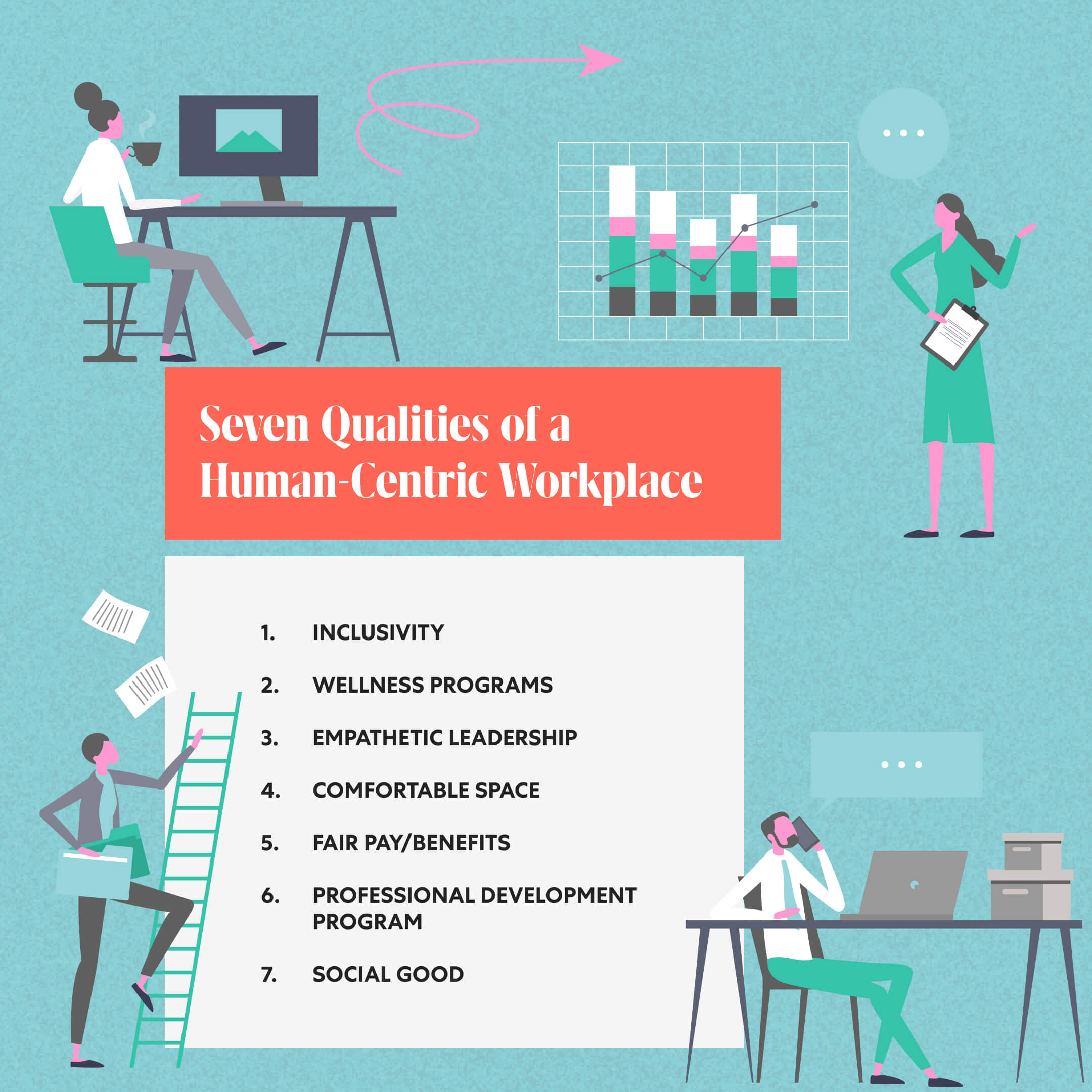7 Qualities of the Human-Centric Workplace for Innovative Leaders

By Fast Company Executive Board
What is a Human-Centric Workplace?
There are two schools of thought on what employees are to a business.
- Grind culture: “Employees are the cogs in my machine. If I use up a cog by working it too hard, I can replace it.” Famously, Amazon demands “unreasonably high” standards, then culls those who get burned out.
- Human-centric: “Employees are humans with multi-faceted lives. If I take their needs into account, I cultivate loyalty and productivity, which in turn benefits the company.” This viewpoint advocates making life and work good for your people, and expecting great returns.
As an innovative business leader, you must remember that your team is made up of human beings. Knowledge workers are not as easily replaced as cogs in a factory wheel. In the wake of the great resignation, with employees leaving posts that make them feel less than human, it’s time for forward-thinking businesses to take a hard look at how they treat their people.
A human-centric leader treats humans as humans, recognizes their struggles and contributions, and makes gratitude and flexibility part of the company culture. This creates an outstanding employee experience that inspires innovation and creativity.
Below, we’ll take a look at seven qualities of a human-centric workplace and how innovative leaders can implement them.

Seven Qualities of a Human-Centric Workplace
Inclusivity
A human-centric workplace welcomes all humans. This means creating an inclusive culture that welcomes every employee’s thoughts, ideas, and cultures. It means a welcoming environment of coexistence.
As Fast Company Executive Board member Heather Hiles, board member of Udemy, says, “A company wins the competition for talent by creating a work environment where people can be themselves. The most successful organizations establish the conditions where people feel safe to bring their full selves to work.”1
Wellness Programs
Once you’ve got the people, your first task is to make sure they are mentally and physically healthy.
Work-life balance has been a hot topic over the past decade. Now, with the advent of COVID-19 and the huge bump in numbers of people working remotely, the terminology is shifting; people are starting to talk about work-life “integration,” since the lines between work and home are blurring.
Unfortunately, the blurring of those lines is leading to increased burnout, and leaders in a human-centric workplace must watch for and take steps to prevent and address burnout. Fast Company Executive Board member Steve Dion, founder and CEO of Dion Leadership, says, “I’ve seen leaders put on their best Zoom face and hide their anxiety just to get through each day. These leaders are zapped of the energy, creativity, and courage needed to truly lead.”2
A creative solution for addressing burnout comes from Fast Company Executive Board member Cody Barbo, founder and CEO of Trust & Will. “To try and prevent burnout in your team, try instituting a friends and family day. Each month, allow every team member to take a flex day for their mental health. Encourage everyone to take off for a full eight-hour workday to take care of themselves. They can run errands, spend time outside, see friends and family—whatever they need to create a healthier work-life balance.”3
Empathetic Leadership
A human-centric leader is the hub of the workplace, connected to each member of the team by a spoke. This means the leader’s attitudes and behaviors spread through the company quickly and influence the overall business environment. In a human-centric workplace, leaders make an effort to embody a leadership style that is positive and empathetic. Actively listening to employees’ concerns is key to making people feel heard and acknowledged.
Empathetic leaders tend to incorporate these three policies:
Flexibility
Be as flexible as you can be regarding schedule, work location, and management. If you allow people to work when and how they prefer, they will give you their best work.
Room for Failure
A human-centric workplace builds in room for productive failure. Knowing that people are human and will make mistakes, an empathic leader creates processes that help people learn from mishaps and move forward.
Gratitude
Visionary leaders don’t just see the business at the highest level. They also notice and show appreciation for employees giving their best.
Above all, empathetic leaders avoid bringing toxicity into the workplace. As Fast Company Executive Board member Cheryl Contee, chief innovation officer of The Impact Seat, says, “It’s especially important for a leader to manage difficult moods and avoid dumping toxicity on your team. “Stop falling asleep in meetings, crying under your desk, drinking too much, and yelling at your assistant. That approach will get you sued or inspire someone to write a damaging internet article about you. It’s possible to both recognize and avoid the curse of C-suite psychosis.” 4
Comfortable Space
Whether it’s a physical or virtual space, your workplace is where you and your employees do your thing all day long. So it should be comfortable, with areas designed to maximize productivity and space for downtime and recharging.
Remote Options
In remote teams, each person has the power to design their own environment. Since we’ve had a pandemic to push us all into the deep end and force us to try out this way of life, many people have found it to be ideal. Leaders who thought their companies weren’t ready or couldn’t operate remotely were forced to adapt quickly, and it turns out — woohoo, it’s possible for almost all office jobs. So consider this option, especially in light of other benefits of remote work for employers.
Refreshing Work Environment
If your industry absolutely demands that people be in a physical office, consider what that office is like. Does it have a human centered design? What bugs you about the space? The same things probably bug your employees. What do you wish it had? A quiet space? An outdoor area? Plants? Find ways to make the space more welcoming and refreshing.
Amenities
Consider offering amenities that might make your employees’ lives more convenient. Big ticket items sometimes offered by large companies include gyms, day care, and cafeterias. But smaller things can make a difference, too. Free snacks. Good coffee. Dry cleaning pickup. A “pets welcome” policy. What perks can you offer?
Fair Pay and Benefits
The people on your team are doing the work that makes your company run. In return, you compensate them.
In a human-centric workplace, compensation covers not just what people need to survive, but what they need to support their families and live fulfilling lives. As more and more corporations get blasted for not providing a living wage, it’s up to you to make sure you’re not among them.
In addition to a paycheck, innovative leaders should put their creativity into building a strong benefits package for employees. Include, at minimum, health insurance and reasonable paid time off. Sometimes generous PTO policy makes all the difference, not only in recruiting strong talent, but also for employee loyalty (and keeping employees functioning at their best).
Professional Development Programs
Humans want opportunities to grow. So a human-centric workplace offers those opportunities. But listing “growth opportunities” in your job descriptions without following through is a mistake. You’ll have to put your words into action — the more specific, the better.
Fast Company Executive Board member Krishna Kutty, managing partner and co-founder of Kuroshio Consulting, suggests working with your employees to create specific individual plans with action items and dates built in. “For each team member, have a clear plan in place that outlines why this growth opportunity fits with their career aspirations and tell them when they can expect it to materialize (e.g., you will have the opportunity to work in our innovation lab, co-developing a product with a client, starting Q4 2021).”5
Individual plans allow you to recognize and develop the strengths of your people. This approach also allows “development equity,” which Fast Company Executive Board member Stephen Bailey, co-founder and CEO of ExecOnline, defines as “equitable access for underrepresented minorities and women to formalized, career-enhancing development opportunities.” He goes on to say that “leadership development programs should provide diverse leaders with opportunities not just to upskill as leaders, but to demonstrate their capabilities in ways that senior leaders and decision-makers can see and support.”6
If you think you don’t have time for individual growth plans, consider that you’re probably doing some kind of annual employee evaluation and goal-setting anyway, so why not use it to make a real difference? Creating these individual plans goes a long way toward helping your employees grow and making your business human-centric.
Social Good
Another thing that characterizes human-centric workplaces is a focus on social good.
Fast Company Executive Board member Chris Schembra, founder of 7:47, says, “Employees increasingly want to feel that their employer is a force for good in the world. Matching employee donations, offering time off for volunteering, or organizing community workdays can foster gratitude and give employees a sense of pride in their workplace.”7
Likewise, Fast Company Executive Board member Marc Inzelstein, co-founder and chief leadership of Indiggo – Return on Leadership, says, “Given that professionals spend more waking hours working than doing anything else, it has also generated a widespread desire to focus on meaningful contributions at work. For those who do not find purpose in their daily work, this is increasingly leading to leaving for jobs that offer greater meaning, or to leaving the workplace altogether.”8
A focus on social good has other benefits, too. “Having a social mission gives organizations the resilience and fortitude to weather changes — be it changes in the market, the economy, or customer demand. Keep your mission top of mind with everything you do and communicate it early and often, especially during your recruiting process. And make sure your employees don’t forget it. When the work you do makes an impact and improves the well-being of people, your mission can be what guides you to do the next right thing,”9 says Fast Company Executive Board member Sascha Mayer, CEO of Mamava
Takeaway
Creating a human-centric workplace is a labor of love — for the visionary leader, the company, and the team within. Attention to and respect for the needs of your people is the best way to keep them fulfilled, growing, and doing their best for your business. As Cody Barbo says, “We should all aim to continue adapting and evolving in a way that puts team members and their families first.”10
Fast Company Executive Board is full of brilliant innovators with experience creating thriving, human-centric workplaces. Learn from them and share your own ideas as a member of this community of decision makers, industry influencers, and thought leaders.
Fast Company Executive Board is an invitation-only, professional network of company founders, executives, and leaders who are defining the future of business. Visit the Fast Company Executive Board membership page or contact us directly to learn more about becoming a member.
Resources
Fast Company Executive board members offer great advice in the articles quoted above. Links to the full articles can be found in each member’s profile:
- 1 “Winning the War for Talent” by Heather Hiles
- 2 “How To Tell if Your Leaders Need a Burnout Coach” by Steve Dion
- 3 “Promoting Work-life Balance in a Time of Burnout” by Cody Barbo
- 4 “C-suite Psychosis: 10 Ways To Spot It and 5 Ways To Avoid It” by Cheryl Contee
- 5 “Retaining Talent During the Great Resignation” by Krishna Kutty
- 6 “How Development Equity Will Define the Future of Work” by Stephen Bailey
- 7 “Gratitude May Be the Secret to Overcoming the Talent Crisis” by Chris Schembra
- 8 “The Need for Purposeful Leadership Amid the Great Resignation” by Marc Inzelstein
- 9 “This Is What Responsible Leadership Looks Like” by Sascha Mayer
- 10 “Promoting Work-life Balance in a Time of Burnout” by Cody Barbo




